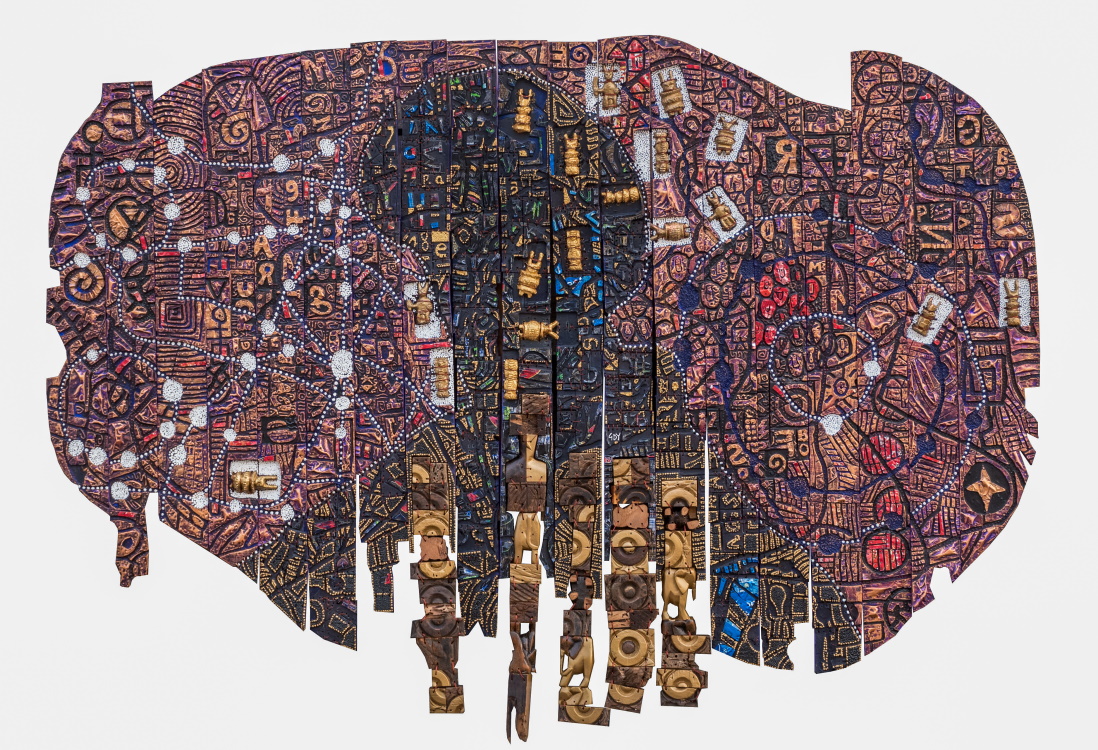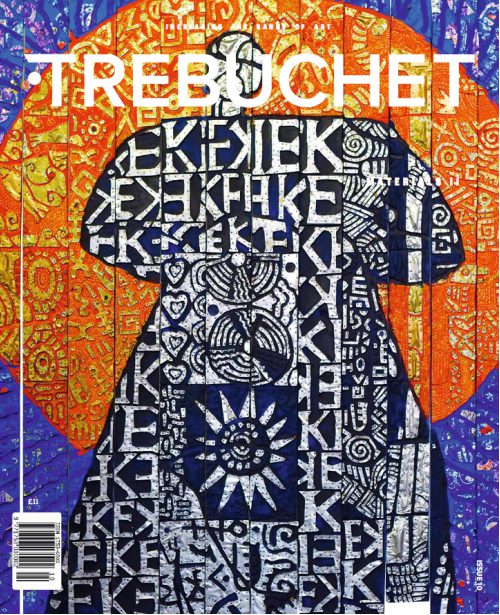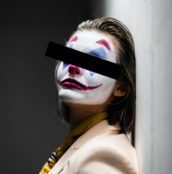The variations of wood as an artistic material create a dialogue with the artist. For many practitioners this tense exchange between their vision and what they’re working with adds a layer of interactive depth that powers their work. The creative process becomes one of reflexive questioning, challenge and compromise and often the results are stronger for coming through this crucible.
Two prominent artists working with wood are Gerald Chukwuma and Michael Armitage. In both cases their work examines history, especially colonial history from a Nigerian and Kenyan perspective respectively. Trained in western painting, they use wood as an active ‘canvas’ background onto which they paint, and from out of which they carve their investigations into African society and culture. The impact of this technique is a layered three dimensional painted experience which is both familiar and strange and that most loaded term; exotic.
Wood, whether as figure, fetish or frame, has an ancient history as our plastic material of creative expression. This long history places contemporary statements on colonial events within a longer pre-invasion narrative, which encourages viewers to see African history less as an ravaged aftermath and more as a continuum of resilient culture, albeit one that is coming to terms with wounds inflicted by the sweep of history and ongoing repercussions to this day.
Trebuchet interviewed Gerald Chukwuma on Eve of his exhibition Eclipse of the Scrolls at the Kristin Hjellegjerde Gallery for Trebuchet 10: Materials
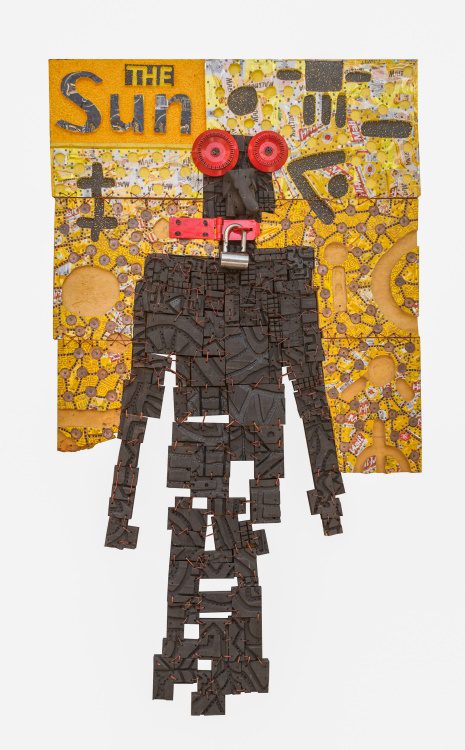
Where did the title come from?
It’s bothered me how our culture has changed, either by withholding information, or by putting out wrong information, or by deliberately putting out half information, this has changed Africa.
Culturally for us in Africa, sometimes in the literature, the text is lacking. It’s not always enough, and underneath there comes something that is not written by us.
So the narrative comes from a perspective that is like a third party perspective. And so, I mean I feel differently (to what is written) but I’m written about differently. I began to understand that sometimes things are orchestrated deliberately, , am I began to ask myself some questions, are we all acting out a drama?
That got me thinking about, mind-control about how these things happen all the time, and you don’t know you’re playing out a script. You might be playing out a script all your life.
I want to take a second look and say, ‘Wait, is there an eclipse of the scrolls?’. It’s not like there are no scrolls, but actually, it is an eclipse. It’s like a cover (over the truth). But someday it’s going to open up our mind and we will realise where we live in a world that has existed for over 5 billion years.
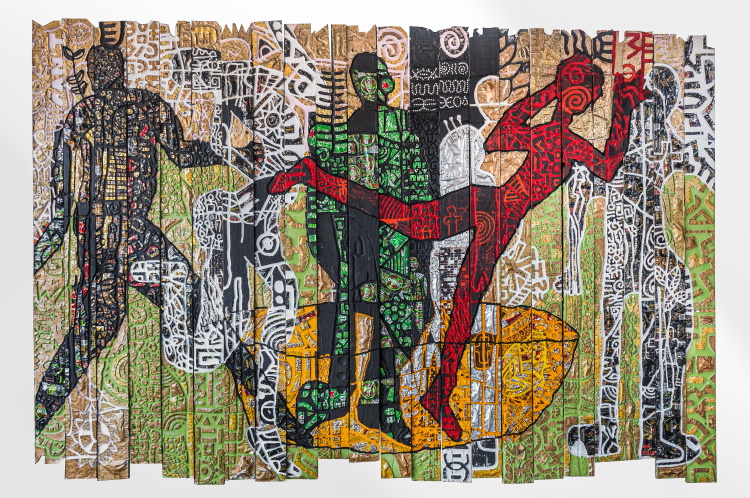
I was researching the Igbo landing (1803) and I tried to find scripts (documents) that talked about the Igbo because it was a significant thing to happen but I didn’t find any. Now that’s why I started to think about scripts and when it first came to my mind that we don’t have any literature, really, that we can hand over—down to our children and our children’s children.
Somehow history has been scraped out of the school curriculum. So that began to worry me a bit and I wanted to do something as big as Igbo landing. I could only find information on the internet and even then you have to scratch it out. That was quite disheartening because if it’s not written down, or documented in any form, then we’re losing history.
“In this new body of work Chukwuma explores the important, historical Igbo Landing site at Dunbar Creek on St. Simons Island, Glynn County, Georgia where one of the largest mass suicides of enslaved people took place in 1803. Travelling to the Georgian coast, Igbo captives from what is now Nigeria, took control of their slave ship and committed mass suicide as a resistance towards slavery.
During his research, Chukwuma was surprised to find little information on the topic in books or on the internet, which lead him to search for verbal histories passed down through families and generations. During these retellings, Chukwuma became fascinated by the wrinkles on the faces of the elderly storytellers, which is the inspiration for these works.” – Wrinkles 2019
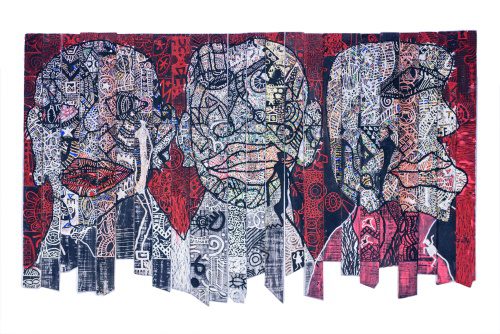
After the wrinkles (KHG show 2019), because I found out that people only had a sketch of information, just a sketch, the idea continued to linger in my head that someday, I was going to point a finger at the fact that something’s happening to our scrolls. It has been doctored, it has been changed but whatever it is, it’s shaping who we are.
Yes the scrolls exist. And they’re a personal truth also because that’s also what my life is like. I didn’t actually start out as an artist. My parents and everybody around me felt that look, you’re gonna waste your time being an artist, can’t you be something else.
So they tried to eclipse my scroll and for 10 years I didn’t do anything. I wandered the streets. I was almost lost, confused. Making art, it’s part of my life so it was as if something was bubbling up I didn’t know what it was. I didn’t do it in high school at all. I had to go back and retrace my steps. Remove the eclipse, I was trying to see what was definite, to read it again and to study art. It was at that stage I went to art school. So, if I didn’t find that I could have made a total eclipse all my life. So yes, a metaphor, but at the same time the truth I wanted to disclose also exists.
Initially I read painting as an artist, and I graduated as a painter, oil and acrylics, but I always loved textures. At some point I realised that there was part of me that always loved textures and layers. So I wanted something else, I wanted something that had texture. So, I think wood has my character.
Why did I choose wood in the first place? Wood is very accommodating. Very romantic and very accommodating. It is very agreeable, will not complain, and receives other things; will receive metal, receives paint, receives glass, receives everything. That’s the kind of person I can work with. So it was easy to meet wood. When I first met wood I just used it as a pictorial background, that’s all, because I wanted textures. But as I worked with wood and I began to find out that we also had a mutual language, we wanted to communicate, wood has a life. Wood wanted to talk, wanted to be loved and so, after many years I found that I didn’t control the act like I used to. I let the wood tell me what to do. And that made me so excited. I enjoyed the work more and more. And so every time I work with wood I am always also looking to find out what the outcomes will be, as I never know the outcome when I start. That keeps me going and coming back. That gives me joy. That makes me.

When I haven’t worked with wood in a while, I sometimes forget that I never finish where I thought I was gonna finish. Wood always has a language, it always wants to behave in a certain way, and if you do not agree with the wood you don’t bring the best out of it. They want to tell a story, they just want you to help, to help him or her tell a story because they’re different. Now, if you also want to tell your story it will help you tell your story. What you have to do is agree with them so that the two of you can speak together.
In the studio I place wood everywhere, all over the walls, I place wood. I cut them and I hang them everywhere. I always come to the studio by 6.30 in the morning every day. And I sit down, they’re very quiet, nobody’s talking, and I start listening. I never have a sketch, I never sketch anything. Once I just get in front of the wood, which is now like a canvas, I just begin to work,
At first I draw into it with the colours. I draw with the colours I need like I’m just playing around. And then I let that stay for sometimes a week, sometimes a month before I’m able to tell why. Then I carve because carving is a big part of the process. Because in carving that’s when I actually have intercourse with a wood.
That’s when I interact with the wood, deeply, it’s like marriage, and this is the beginning of the discussion, and it’s in carving that it comes out. In carving I find some things out and it’ll make me continue that way. Or not. Sometimes the wood would refuse, and not in other words, or not continue. Sometimes I’ll let them stand for six months before I can touch them.
That’s how I start to carve and then after the carving I burn it of course to produce my black feelings. As well as to treat the wood at the same time. Then after that, one of the things I have tried to do over the years is to try to make sure that it doesn’t appear as wood again. Every one of my work you may not know it is wood until you get close. But initially when I started, it wasn’t like that, because we had the wood.
How does it start do you buy the wood as planks
I’ve the machines to make them planks. I prefer that because I like wood that is a little mature. So I don’t often buy planks. I go to the wood market then they roll them out and when they roll them out I choose the particular ones I want. I have a pretty large studio and I have machines that will cut them. With planks sometimes I couldn’t tell the difference between a mature plant and one that is more immature until I start working on it. It made me feel really sad because it’s like I’ve used something that has not grown. It should have been growing. So, I stopped doing it. So I had to get the machines so I could be sure that this wood is ripe enough, ready to come out. Otherwise it was just like getting married to a young girl who’s not of age. That’s not a good thing. That’s child abuse really. So I wait until the point that the wood is ready to come out and speak. You can’t really tell if you see that block. If you see the planks you will not tell if it’s somebody very young, people want to make money. So yeah, I have the machine that slices them. Then I put them on the wall.
Is there a physical difference in working with mature wood versus working with young wood that you particularly like?
Technically when you’re working with immature wood I find out that it is easier to work. Now, while it is easier to work, not that I prefer it to be hard but it’s like romance, you have to work, it’s work that you have to spend time with. It shouldn’t be that easy, otherwise you will even lose the idea of the work because you’re moving too quickly. When it is mature it’s a bit harder. And so it takes a little time, the grooves are also smooth. The groove are smarter. They don’t fight.They don’t fight, your carving materials. No, they allow it. If the wood isn’t very mature they sometimes bring out some things that aren’t great. For instance, you can puncture the wood as you’re carving it. So the drier wood helps you a bit as you’re carving it, you’re not getting the best out of anything when it’s too easy. And so you can almost manipulate the wood which is not a good feeling for me.
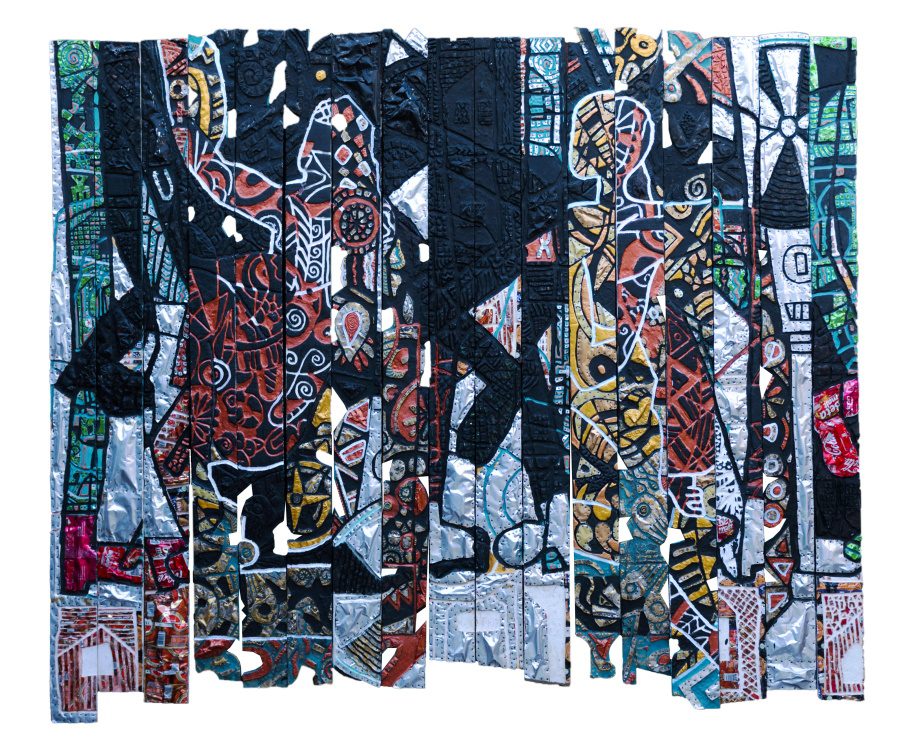
You’re speaking about wood in very human terms.
Oh well, it’s a living thing. It is just like us, we are living in the same world. It’s serving this purpose and we have come to serve our purposes here, and some of us can be this or that. You’re interviewing me, and we may do this or not but we’re serving our purpose. So, I mean the wood is serving it’s living purpose, even while you’re working on it. If you are trained and have worked for a while with wood and other materials, you’ll be able to hear them actually speak, they have languages, they talk. Yes, they tell you certain things because when I sit down with it, suddenly, I hear them and I know what it means. You may say it’s practice but there are things that I know don’t just come just like that. These things God has put them in this wood to communicate to us, if we’re supposed to use them. For me, I believe that, yes.
Can you discuss the variation in your work, planks, layers, how do you create the layers and find the figures?
With ROCK THE BOAT BABY (2021), it’s about rocking the boat. So, rocking the narrative, and finding out the truth and saying ‘ wow’. In terms of the processes. You know when I get the wood sometimes the process comes much later and in its own order. Like this one, the background came before the figures. Yes, the entire background was covered completely, because I didn’t know what I wanted to do, but I knew I wanted to tell the story. So I started to tell my story from the setting, not the theme, not the plots, but the setting. So I know the village I want to talk about but what I don’t know is who I’m talking about in the village. So I did an entire background and when I was finished it was only then the figures really started to come in one by one. The lady rocking the boat was actually the last one to come.
I’d finished all the figures, and had done the boat. Even before the title, rock the boat baby came, I discovered that a lady was gonna rock the boat so only then did I draw her in. My goodness. I enjoyed that because she’s (a way of showing) how in Africa we’ve been lied to. We’ve been led to believe that women have to be this or that. That’s not true. So when this lady comes in just like ‘well why can’t I be the president’, ‘Why can’t I rule the place’, ‘why can’t I be a general?’ that’s the truth. So yes, it’s a metaphor, but also It’s a reality that we suddenly found out the truth in the scrolls, that wasn’t even what was supposed to be there. They have masked the information from us. That’s why we behave this way. That’s why they behave that way. So it’s a metaphor but sometimes it’s also reality.
When people see my pieces . They feel that ‘Oh, my goodness, so much work!’. That’s the first thing. Especially artists or people who work with wood. But it’s not so much work for me, I just enjoy it and as I said, the longer you stay with it, the better. That’s why I choose mature wood, but also I find out that I get shocked when I see my work hanging on the wall. I have tried to understand why, but I’ve just realised that in the process of the work. I don’t know the outcome, truly, and when I finish. It looks nice, okay it’s nice, but when it hangs on the wall. I immediately take the position of the person who purchased it or was exhibiting it, and I began to see what I didn’t plan to do. But that is another stretch that I’m not able to understand, but I enjoyed it. Which is to say that every time I see my work on the wall I wonder why did I give it out? I always feel that feeling. So I’m also surprised at my work, some other people have said it was very imposing. I noticed that you can you hang it anywhere and when you walk in, you will have to look at it, because it’s quite imposing. It’s wood, of course, and wood has a character of being strong. The character of wood, the texture of wood, we have the same kind of materials (in us) as wood so it’s the same thing.
How long have you been working with wood.
18 years, but when I started I was afraid. I didn’t want to spoil the wood when I work. I didn’t want to make a mistake, because I know that the wood is not like Canvas. I can’t paint over it if I carve it and I make a mistake I can’t cover it again. So I learnt that through use wood is a very beautiful material, it helps you. So, it encouraged me and even with the mistakes I still see beautiful things happening at the end of the day. So, now the truth is this, I’ve become so close to wood that, I don’t want to sound too confident but, I don’t think there can be any mistakes. Whatever happens when I work with wood, it appears that the wood will help me. It also helps that with wood we enjoy ourselves. It may not pass the artistic test, whatever, it’s ok for me. It’s okay. If I’m happy and the wood is happy that’s enough.
When you say you see the work on the wall in a gallery do you see it as the end of your relationship with it, or maybe you’re moving out or something else.
I’m happy. Every one of my works is like a child. We all want our children to stay with us but it will also be terrible if we don’t let them go. Go to get a good education, to get married, to live so this is a mixed feeling. I wish I could take them all back, but I get so excited when I see how the person loves the work. I get so excited. It’s just joyful. So, that is enough consolation.
I don’t go and stay at my exhibitions after the first opening. I don’t like to sit by and watch. And I want to make money, of course, but I just sometimes its like ‘Oh, am I gonna meet her again?’ Sometimes I do meet them so I tell them well be a good ambassador wherever you’re going. Sometimes I meet them and I’m so glad.
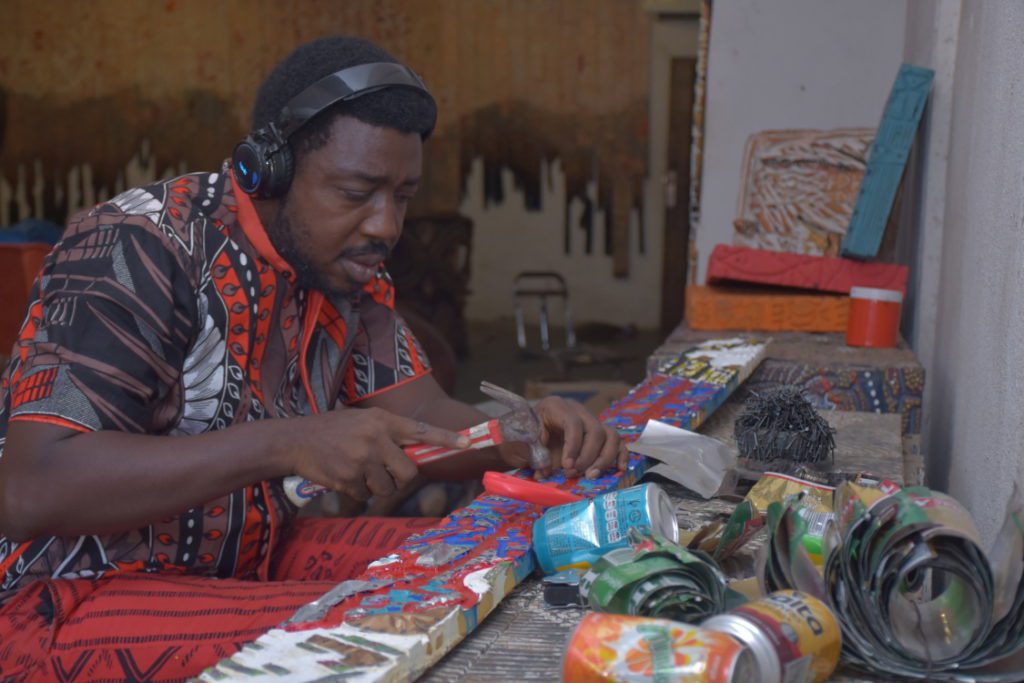
You said earlier you burn your pieces to seal them. So, do you set a line the planks, paint the planks, if we carve into those painted areas I guess those sections, And then you burn them. And then you have to repaint them?
Sometimes I have to repaint them, and sometimes I’ll recarve them. For instance, ROCK THE BOAT BABY, I burnt everything black. I had applied the first coat of colour I covered one colour completely. And then I said, Wait, who is rocking the boat. So when I was carving the lady out I had already painted. Now what it is is I’m gonna have to burn it again. So when I’m burning in the acetylene gas will touch it everywhere. Again, it doesn’t matter. I will go back again if I have to.
First of all, I’m comfortable as a painter. And so because I have graduated as a painter, it’s always beautiful to repaint again and again. But the process is not, just carving, there’s a carving there’s burning, there’s just a lot of metalwork, a lot of, upcycled materials.
I want to find a way to take care of things also here (Lagos). We have a lot of empty cans here and they’re getting into the sea. The first time I went to the beach here, the first time I’ve ever saw the sea, I was shocked to see cans rolling out of the water. As an artist I saw that all the can had colours on them so I said well what can I do with it. So all the, all the colours you see on most of those work, For instance, we look at time, you will see that the placement, TIME (2021) does the headline. If you look closely you see that empty cans are beat into the wood. I use a lot of it. A lot, a lot of aluminium cans. So that’s something that I also do and of course wood makes it possible. If you look at all the works they have a lot of aluminium cans. We have no recycling here, everything has been littered everywhere so what do I do? How do I do my own path? Am I wrong? You know when I say I’m an environmentalist this is how I help, perhaps to balance using wood.
Gerald. Thank you very much for your time. It’s been fantastic speaking to you.
You too. Take care, again. Bye.
Gerald Chukwuma is represented by Kristin Hjellegjerde Gallery

The aim of art is to represent not the outward appearance of things, but their inward significance. – Aristotle

